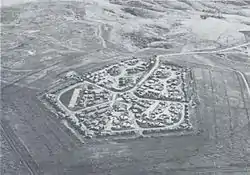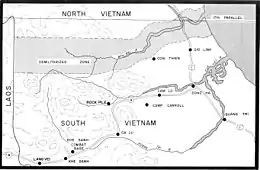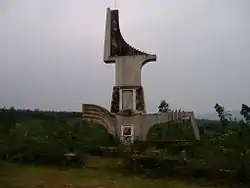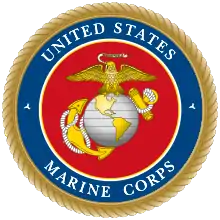Camp Carroll
Camp Carroll (also known as Artillery Plateau, Firebase Tan Lam and Hill 241) was a United States Marine Corps and Army of the Republic of Vietnam (ARVN) artillery base during the Vietnam War. It was located 8 km southwest of Cam Lộ, Quang Tri Province. Camp Carroll was also at the centroid of a large arc of the strategic Highway 9 corridor south of the Vietnamese Demilitarized Zone (DMZ), which made it a key facility.
| Camp Carroll | |
|---|---|
 An overhead shot of Camp Carroll | |
| Coordinates | 16°45′47″N 106°55′50″E |
| Type | Marine Base |
| Site information | |
| Condition | abandoned |
| Site history | |
| Built | 1966 |
| In use | 1966–-72 |
| Battles/wars | Vietnam War |
| Garrison information | |
| Occupants | 3rd Division |
History
1966–70

The 3rd Marine Division had overall command and control of the DMZ area.[1] The camp was commissioned on November 10, 1966 (aka Camp J. J. Carroll) and became home for the 3rd Marine Regiment. The camp was named after Navy Cross recipient Captain James J. Carroll, who was the commanding officer of Kilo Company, 3rd Battalion, 4th Marines, and was killed by friendly tank fire on October 5, 1966 during Operation Prairie.[2] It was one of nine artillery bases constructed along the DMZ and had 80 artillery pieces including M107 175mm guns from the United States Army; the longest ranged, but least accurate American field artillery pieces, the 175mm could fire a 150-pound projectile 32,690 meters and effectively return fire on any enemy gun that could hit it. The 175mm guns put Camp Carroll on the map, particularly the tactical maps of the North Vietnamese forward observers.
Camp Carroll diminished in significance after the 1968 Tet Offensive. The 3rd Marine Division began relying on highly mobile postures rather than remaining in their fixed positions as sitting targets and Camp Carroll was inactivated on 28 December 1968.[3] Camp Carroll became an Army of the Republic of Vietnam (ARVN) base.
1972
On 30 March 1972, the North Vietnamese People's Army of Vietnam (PAVN) launched their Easter Offensive. PAVN rockets and artillery shells slammed into Camp Carroll. The base received more than 200 rounds of 130mm fire in the first hour of the attack. On 2 April 1972, ARVN Lieutenant Colonel Pham Van Dinh, commander of the 56th Regiment, 3rd Division, surrendered the facility to the PAVN. B-52 strikes were ordered against Camp Carroll in an effort to deny its use to the PAVN. However, the PAVN removed the 175mm guns from the camp before the strikes could occur. These guns were later used against the ARVN.[4]

Current use
At present the land belongs to Xi Nghiep Ho Tieu Lam, the Vietnamese state-operated pepper enterprise.
Other
Camp Carroll also refers to a U.S. Army camp located in Waegwan, South Korea. It is referred to as "The Crown Jewel of Area 4".
References
- Pike, COL Thomas F. Military Records, February 1968, 3rd Marine Division: The Tet Offensive. Charleston: Creatspace. ISBN 978-1-481219-46-4.
- Coan, James P. (2004). Con Thien - Hill of Angels. The University of Alabama Press. p. 49. ISBN 0-8173-1414-8.
- "Headquarters MACV Monthly Summary December 1968" (PDF). Headquarters United States Military Assistance Command, Vietnam. 15 February 1969. p. 44. Retrieved 9 March 2020.
 This article incorporates text from this source, which is in the public domain.
This article incorporates text from this source, which is in the public domain. - Brush, Peter. "Big Guns of Camp Carroll". Leatherneck.com. Retrieved 23 January 2018.
External links
| Wikimedia Commons has media related to Camp Carroll. |
- Army map of Camp Carroll location
- Brush, Peter. "Big Guns of Camp Carroll". Leatherneck.com. Retrieved January 22, 2018.
- Surrender of Camp Carroll, vnafmamn.com
- Modern photos and video of the site
